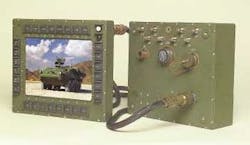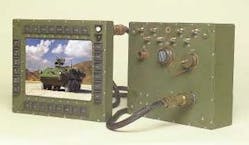Displays
General Dynamics uses IEC displays in Stryker
Engineers at General Dynamics Land Systems in Sterling Heights, Mich., needed video display terminals for various types of Stryker Brigade Combat Teams. They chose a solution from Interstate Electronics Corp. (IEC) in Anaheim, Calif., a subsidiary of L-3 Communications.
As of November 2004, IEC had delivered 1,028 units, including two product variations - one for vetronics and Light Armored Vehicle requirements and one for space-constrained applications.
The Enhanced Video Display Terminal (VDT-E) is designed to meet the future Vetronics requirements of the Brigade Combat Team and international Light Armored Vehicle (LAV) requirements. The enhancements included additional memory and storage, a Controller Area Network (CAN) interface, additional hard-wired bezel buttons for fire control, and other user-defined applications.
The Split Enhanced Video Display Terminal (VDT-S) repackaged the VDT-E for space-constrained applications within ground military vehicles. The VDT-S separates the display and backlight from the computer and power supply and incorporates a higher-resolution LCD and a faster computer, remote firing units, targeting computers, GPS tracking capability, and FBCB2. It will be modified to integrate with an Army air-defense system’s fire-control system. General Dynamics picked the VDT-S because it can consolidate several existing systems into one platform.
IEC provides the Stryker vehicle Squad Leader’s VDT. The rugged display meets standards of temperature (from -4052°C), shock and random vibration, and NBC (nuclear, biological, and chemical) resistance. The display is for the vehicle’s Squad Leader for battlefield awareness, displaying video from daylight- and night-vision cameras, hosting the integral training system, and integrating with the Force XXI Battle Command, Brigade-and-Below (FBCB2) computer. For more information, see www.iechome.com.
software
Army uses intrusion software to stop hackers
Army engineers at the Directorate of Information Management (DOIM) located at Fort Hood, Texas, needed software to block hackers, viruses, and spyware.
They found a solution with SecureNet and SpySnare, both from Intrusion Inc., Richardson, Texas.
Under the $800,000 phase-one contract, Army technicians will deploy the SecureNet intrusion detection/prevention system and SpySnare spyware prevention system.
Intrusion’s SecureNet system detects and blocks unauthorized network intrusions. The Fort Hood SecureNet installation addresses the common “insider threat” behind the site’s perimeter firewall, where many of the greatest potential vulnerabilities exist. SecureNet sensors are deployed lower into the site’s network, at the department level, and thus, increase threat visibility across the full network.
“We’re taking a proactive stance to make ourselves better and more relevant in our information warfare and cyber security mission,” explained Lt. Col. Ed Morris, director of the Ft. Hood DOIM. “With the SecureNet deployment at Ft. Hood, we are able to get specific details about whom we’re fighting and from where they came. Once we get the enemy in our sights, we are able to take aim and eliminate the offender.” For more information, see www.intrusion.com
Power electronics
Northrop Grumman uses Vektrex power interface on F-35
Engineers at Northrop Grumman Corp. in San Diego needed a power interface for the communications test system used on the F-35 Joint Strike Fighter. They found a solution with Vektrex, also of San Diego. The interface will help perform high-fidelity power testing on F-35 communications avionics.
The communications avionics are being developed by engineers in the Radio Systems business of Northrop Grumman’s Space Technology sector, under contract to Lockheed Martin.
The system will enable over 35 communications, navigation, and identification (CNI) functions, such as voice and data communications, automatic acquisition of fly-to points, and friend-or-foe identification. Using software-defined radio technology, Northrop Grumman’s CNI system is a fraction of the size and weight of the single-function radios previously required to implement those functions.
“We are pleased that the technology developed by Vektrex will play an important role in F-35 avionics testing,” says Ken Fecteau, F-35 CNI program director, Northrop Grumman Space Technology. “This is an example of how innovations by small businesses enhance the products that we provide to our customers.”
Vektrex’s technology will improve the power-interface integrity of the F-35 CNI avionics to reduce risk to the flight-testing phase. For more information, see www.vektrex.com.
Software
Lockheed Martin uses Gedae to test laser radar
Engineers at Lockheed Martin were planning a Captive Flight Test (CFT) of a laser radar (LADAR) seeker.
They needed software to provide real-time automatic target recognition (ATR) algorithms, and found a solution in the Graphical Entry Distributed Application Environment from Gedae Inc. in Mount Laurel, N.J.
Lockheed technicians used the software to partition the algorithms to different processors, then identify and correct potential processing bottlenecks.
“As we continue to evaluate ways of making our systems more robust and operationally effective, it’s encouraging to have a success like this using state-of-the-art tools,” says Walter H. Delashmit, systems engineer senior staff at Lockheed Martin Missiles and Fire Control in Dallas.
Gedae, a block-diagramming programming tool, automatically implements deployable software. Gedae generates code for embedded hardware after the system software functionality has been developed and verified on a workstation. The result rivals hand-coded efficiency and quality, but with dramatically less development effort, company officials say. Applications include signal and data processing, application control, and integration with other systems.
Gedae is available for various COTS real-time embedded architectures from Bittware, CSPI, Dy4/Ixthos, Mercury, Motorola Systems, Sky, and Transtech. For more information, see www.gedae.com.
Trilogy uses Nucleus RTOS for communications device
Engineers at Trilogy Broadcast Ltd. in Hampshire, England, needed a real-time operating system for their Mercury system, an Internet Protocol (IP) voice-based communication device. They selected the Nucleus RTOS from Accelerated Technology of Mobile, Ala., a division of Mentor Graphics.
The Mercury system uses Voice over Internet Protocol (VoIP) to connect all elements of the system over standard Ethernet. That means it can offer bidirectional audio communication, near-instant connection across LAN and WAN configurations, and multimember conferences (party lines) between members.
“We received excellent technical support from Accelerated Technology,” says Phil Luke, development manager at Trilogy Broadcast. “That support, combined with the source code, royalty-free licensing model and the rich features of the Nucleus RTOS, has made our Mercury system a success.”
Developers at Trilogy chose the Nucleus RTOS because of its robust features and royalty-free licensing model, company officials say. The features of VoIP technology demanded an RTOS that was optimized and scalable. For more information, see www.acceleratedtechnology.com.
Displays
Thales uses L-3 display in British light-armored vehicle
Engineers at Thales Defense Optronics needed a display module to show infrared data in their Drivers Vision Enhancer (DVE) system for the driver’s compartment of the British Army’s Future Command and Liaison Vehicle (FCLV).
They found a solution with L-3 Communications Ruggedized Command & Control Solutions (L-3 RCCS) in San Diego. The Display and Control Module from L-3 had to be compact and lightweight, to enhance situational awareness and boost vehicle safety. Thales is under contract to manufacture more than 400 DVE systems, marking the first volume introduction of uncooled thermal-imaging driver sight systems.
“The Thales/L-3 team offers the U.K. vehicle community an around-the-clock driving capability with significant improvement to the warfighter’s situational awareness and safety. Our team offers the highest performance system at an affordable price and we are delighted that our system has been selected for this important program,” says Jim Mazur, president of L-3 RCCS.
The RCCS product line includes a variety of rugged displays and computer processor system solutions, supporting multiple system architectures for shipboard, airborne, and wheeled and track vehicle applications. For more information, see www.L-3Com.com/rcc.




